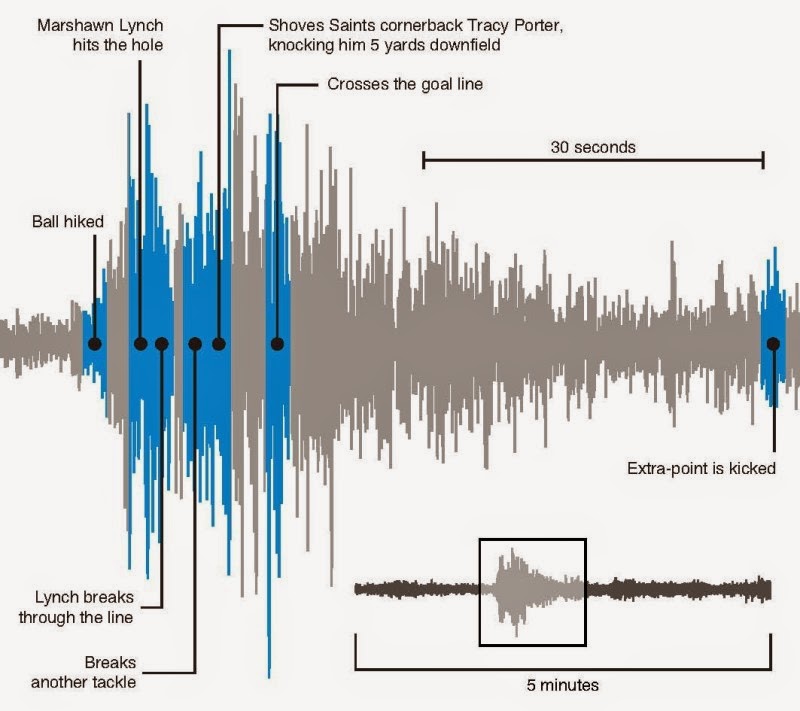
It’s not just the football players who have spent a year training. University of Washington seismologists will again be monitoring the ground-shaking cheers of Seahawks fans, this year with a bigger team, better technology and faster response times.
Scientists with the Pacific Northwest Seismic Network will install instruments this Thursday to provide real-time monitoring of the stadium’s movement during the 2015 NFL playoffs.
This year, the UW researchers have also upped their game. A new QuickShake tool will provide a faster connection between the sensors and the website. This Saturday will be the first test of the software that displays vibrations within three seconds — five to 10 times faster and more reliably than readings from the same sensors installed last year.
The Pacific Northwest Seismic Network monitors earthquake and volcanic activity throughout the region. Network scientists first got interested in football when a seismometer a block away from the stadium showed vibrations during Marshawn Lynch’s legendary Jan. 8, 2011, touchdown run. The resulting seismograph became a celebrity in its own right and coined the term “Beast Quake.”
After a couple of quieter years, the group got permission last year to place two strong-motion earthquake sensors inside the stadium. The project was a huge hit and the group added a third sensor for the 2014 playoff game.
A Beast Quake happens when the energetic jumping and stomping of so many fans at once shakes the stadium and reverberates through the surrounding soil. Seahawks fans also generate record-breaking noise, of course, but sound waves don’t rock the building. A guaranteed shaking event with significant public interest is a great test case.
“We’re mostly interested in the speed and the reliability of the communications,” said John Vidale, a UW professor of Earth & space sciences and director of the seismic network. “It’s hard to simulate thousands of people using this tool all at once. When we can get a lot of people looking, we can see problems that we’d encounter during an actual earthquake.”
For fans at home, the faster data transfer means that TV viewers may get a tipoff to a big play they’ll see on the screen after the 10-second broadcast delay. The researchers have dubbed them “Early Football Rowdiness Warnings.”
The foot-stomping is a real-world test of technology to detect the bigger shaking that originates underground. The seismic group is working with the U.S. Geological Survey to offer early warnings for the Pacific Northwest that could provide tens of seconds to several minutes’ notice of an incoming strong shaking. This year some public agencies and large businesses will have a first chance to try out the system that will eventually be available to the public.
“The Seahawks experiment should provide us and the Internet-connected public with a feel for the minimum time early warning might provide,” said Steve Malone, a UW professor emeritus of Earth & space sciences. “In this case it’s football fan activity that generates a signal as a warning for what shows up on TV some seconds later. In the future, it might be seconds to minutes of warning after an earthquake starts.”
This weekend the group will be beefing up its social-media presence to post updates and respond to questions during the game. That also helps get ready for an emergency situation.
“During the rumblings on Mt. St. Helens a decade ago there was a huge influx of Web visits and phone calls,” Malone said. “Now with social media, it’s a whole new ballgame. We’ve got to learn how to deal with that because it’s going to snow us over if we’re not prepared.”
The group will have more staff monitoring social media during the game, and more robust websites that they hope won’t slow down or crash during heavy traffic.
On the scientific side, they hope to explore the different readings between the three sensors placed at different levels. They also hope to explain some mysterious patterns of shaking during commercial breaks, what one researchers hypothesizes may be a “dance quake.”
Several researchers will be at the UW campus lab Saturday monitoring the sensors. Two group members will be at the stadium providing eyes on the ground to help explain what could be causing any unusual spikes. They will be rooting for a victory for the Seahawks — and for science.
“We’re developing these new Web tools, and monitoring the game really motivates everyone to get excited,” Vidale said, “and we’re rooting for a second helping of roars and rumbles against the Packers or Cowboys to perfect the system.”
Note : The above story is based on materials provided by University of Washington. The original article was written by Hannah Hickey.










